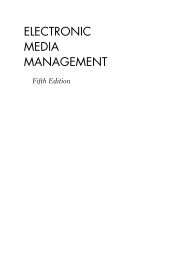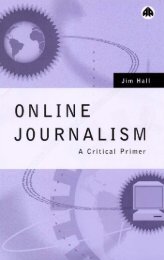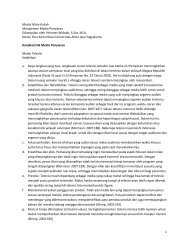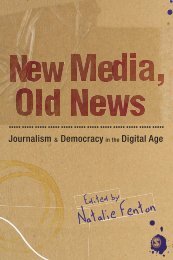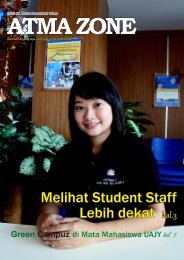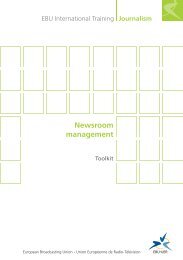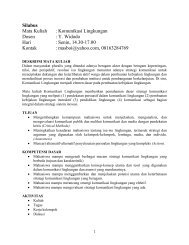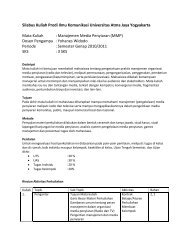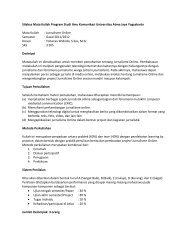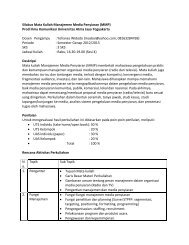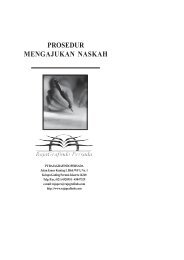Modul Mata Kuliah Journalisme Online - Ayo Menulis FISIP UAJY
Modul Mata Kuliah Journalisme Online - Ayo Menulis FISIP UAJY
Modul Mata Kuliah Journalisme Online - Ayo Menulis FISIP UAJY
You also want an ePaper? Increase the reach of your titles
YUMPU automatically turns print PDFs into web optimized ePapers that Google loves.
Many CJ and Web 2.0 projects fall into the categories of mini-projects, demonstration prototypes and<br />
start-ups, even when using a programming language such as Ajax or Ruby on Rails. Whilst the<br />
“bootstrap” process is a benefit, more longitudinal analysis and testing needs to occur, to ensure these<br />
projects are scalable and sustainable. For example, South Korea’s OhmyNews is cited as an exemplar<br />
that started with “727 citizen reporters and 4 editors” and now has “38,000 citizen reporters” and “a<br />
dozen editors” (Kolodzy 231). How does OhmyNews’s mix of hard and soft news change over time? Or,<br />
how does OhmyNews deal with a complex issue that might require major resources, such as security<br />
negotiations between North and South Korea? Such examples could do with further research.<br />
We need to go beyond “the vision thing” and look at the messiness of execution for deeper observations<br />
and counterintuitive correlations, to build new descriptive theories.<br />
9. Future Research<br />
This essay argues that CJ needs re-evaluation. Its immediate legacy might be to splinter ‘journalism’ into<br />
micro-trends: Washington University’s Steve Boriss proclaims “citizen journalism is dead. Expert<br />
journalism is the future.” (Boriss; Mensching). The half-lives of such micro-trends demand new<br />
categorisations, which in turn prematurely feeds the theory-building cycle.<br />
Instead, future researchers could reinvigorate 21st century journalism if they ask deeper questions and<br />
return to the observation stage of building descriptive theories. In closing, below are some possible<br />
questions that future researchers might explore:<br />
Where are the “rich descriptions” of journalistic experience—“citizen”, “convergent”, “digital”,<br />
“Pro-Am” or otherwise in new media?<br />
How could practice-based approaches inform this research instead of relying on espoused<br />
theories-in-use?<br />
What new methodologies could be developed for CJ implementation?<br />
What role can the “heroic” individual reporter or editor have in “the swarm”?<br />
Do the claims about OhmyNews and other sites stand up to longitudinal observation?<br />
Are the theories used to justify Citizen Journalism’s normative stance (Rheingold; Surowiecki;<br />
Pesce) truly robust generalisations for strategic execution or do they reflect the biases of their<br />
creators?<br />
How could developers tap the conceptual dimensions of information technology innovation<br />
(Shasha) to create the next Facebook, MySpace or Wikipedia?<br />
References<br />
Argyris, Chris, and Donald Schon. Theory in Practice. San Francisco: Jossey-Bass Publishers, 1976.<br />
Barlow, Aaron. The Rise of the Blogosphere. Westport, CN: Praeger Publishers, 2007.<br />
Block, Peter. Flawless Consulting. 2nd ed. San Francisco, CA: Jossey-Bass/Pfeiffer, 2000.<br />
Boriss, Steve. “Citizen Journalism Is Dead. Expert Journalism Is the Future.” The Future of News. 28 Nov.<br />
2007. 20 Feb. 2008 < http://thefutureofnews.com/2007/11/28/citizen-journalism-is-dead- expertjournalism-is-the-future/<br />
>.<br />
Brooks, Jr., Frederick P. The Mythical Man-Month: Essays on Software Engineering. Rev. ed. Reading,<br />
MA: Addison-Wesley Publishing Company, 1995.<br />
Campbell, Vincent. Information Age Journalism: Journalism in an International Context. New York:<br />
Arnold, 2004.



